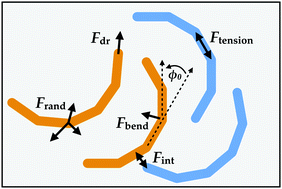Chiral self-sorting of active semiflexible filaments with intrinsic curvature†
Abstract
Many-body interactions in systems of active matter can cause particles to move collectively and self-organize into dynamic structures with long-range order. In cells, the self-assembly of cytoskeletal filaments is critical for cellular motility, structure, intracellular transport, and division. Semiflexible cytoskeletal filaments driven by polymerization or motor-protein interactions on a two-dimensional substrate, such as the cell cortex, can induce filament bending and curvature leading to interesting collective behavior. For example, the bacterial cell-division filament FtsZ is known to have intrinsic curvature that causes it to self-organize into rings and vortices, and recent experiments reconstituting the collective motion of microtubules driven by motor proteins on a surface have observed chiral symmetry breaking of the collective behavior due to motor-induced curvature of the filaments. Previous work on the self-organization of driven filament systems have not studied the effects of curvature and filament structure on collective behavior. In this work, we present Brownian dynamics simulation results of driven semiflexible filaments with intrinsic curvature and investigate how the interplay between filament rigidity and radius of curvature can tune the self-organization behavior in homochiral systems and heterochiral mixtures. We find a curvature-induced reorganization from polar flocks to self-sorted chiral clusters, which is modified by filament flexibility. This transition changes filament transport from ballistic to diffusive at long timescales.



 Please wait while we load your content...
Please wait while we load your content...
